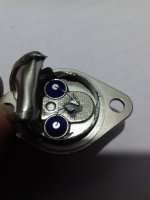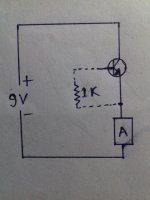Thanks.@tip33I'm describing my multimeter test......
At first i set the meter at diode/continuty range~
(btw i hve two DMM, same result)
1st transistor symtom________
Red probe on Base & black probe on Emitter/Collector...."No reading"!! Same happens between Emitter(Red) to Base/Collector (black)which is normal.
But why no reading between base to emitter/collector?!
2nd & 3rd transistor symtom_______
Red probe on Collector & black on Emitter...showing some reading! Around 650-600! Slowly decreasing around 550. Leakage? when i change the probes Emitter(R) to Collector(B)...No reading, which is normal. But why reading between Collector to Emitter? Same happens in 2kohm/diode range on another meter.
**(1st transistor passed 2nd & 3rd transistor test & vice versa).
Clear enough now.
Would never have believed such poor readings.
I mean, faking is a business , even if a shady one.
Parts must "work" , sort of, even if failing under stress , and if returned, seller sees bolt scratch marks, solder and rosin on pins, thermal grease smears on surface and can say: "hey, YOU blew them" but when still not paid for parts can be rejected over the counter with a simple multimeter test ... WTF???
No way those parts were sold by CDIL to anybody.
Fakers put something inside, check examples above of a TIP31/TIP41 size die , mounted straight to steel base with no copper spreader disk, covered in a drop of the infamous white epoxy ... but those pass a simple diode test, even show some Hfe on a meter, etc.
But those gross fakes, are the same as a street corner drug vendor giving sugar or salt or chalk to customers ... within 10 minutes he´ll have his face smashed or a knife blade in his guts.
@JMFahey But half of them(3 out of six) behaving normal. Passed meter test. I also believe that they obtained those from an unreliable source/not authorised by CDIL. Or maybe simply manufacturing fault. Because the vendor is reputed. Their review is also very good(in indian diy community).
I also purchased mjl21193/94 from that store & those are genuine.
I also purchased mjl21193/94 from that store & those are genuine.
Having read all the later posts there is no point you trying what I suggested earlier.
I think the only way you will know for sure would be to return them to CDIL who could verify them or not. I wouldn't be to quick to blame CDI though without conclusive proof, particularly if there is a possibility they are just faked parts.
Connect it across a 9v battery with an ammeter in circuit. Base open circuit. What current do you see.
I think the only way you will know for sure would be to return them to CDIL who could verify them or not. I wouldn't be to quick to blame CDI though without conclusive proof, particularly if there is a possibility they are just faked parts.
I said tomorrow i'll try what you suggested. Currently it's 1:33 am, so Good night from this part of earth 🙂
I came across CDIL MPSA06‘s that turned out to be PNP
A similar thing has happened to me many years ago. Edit... should just say this probably before CDIL existed so not pointing the finger at them in this case.
Remember buying 30 or so MPSA06/56 npn/pnp pairs a few years back.A few of the MPSA56 pnp's were actually npn's -unbelievable.Also some MJE340/350 's did'nt look too clever, a quick rub with iso revealed some obscure 40xxx no.All from reputable source as well.
so Good night from this part of earth

It is not a question of money. DIY lovers spend a lot of money on their hobby. so thats not the point. My moot question was that atleast the management of CDIL must be informed through an email regarding manufacturing defect.Quite cheap so no problem.
Had you not checked these transistors before using them in the circuit, it could have damaged the other components of the circuit as well.
Last edited:
CDIL established 10 December 1964, $122 Million revenue, 637 employees.
Not a small setup, well established.
I would send them the samples, and a copy of the invoice.
Not a small setup, well established.
I would send them the samples, and a copy of the invoice.
Looks like pieces of the die vaporized. But the die itself LOOKS like an original Motorola/ON high power standard epi-base layout. The package uses a different heat spreader than ON uses (different shape), but they do have the die at a diagonal like they are supposed to. They were at least trying to build it right. The die might have been NFG before it went in the can, don‘t know if they do 100% functional test. Or if the retailers get the rejects like Radio Shack used to (was well documented at one time).
@wg_ski
I completely agree with you, as i said before this is a clear case of QC or some dishonest worker of CDIL factory doing this backdoor business. They're destroying the reputation of their own company. The die size & heat spreader looks similar to ST 2n3055.
@katiyar I contacted diyaudiocart through whatsaap(usually responds) but they're maintaining complete silence in this issue! Anyway you convinced me to write an email to CDIL.
I completely agree with you, as i said before this is a clear case of QC or some dishonest worker of CDIL factory doing this backdoor business. They're destroying the reputation of their own company. The die size & heat spreader looks similar to ST 2n3055.
@katiyar I contacted diyaudiocart through whatsaap(usually responds) but they're maintaining complete silence in this issue! Anyway you convinced me to write an email to CDIL.
No doubt about that. Original but rejected batch.Broken die surely rejected batch
CDIL distributor here asked me about Rs73 per transistor for minimum quantity of 100 pieces , how they selling it for Rs42? even BEL 2N3055 goes close to rs120 minimum , how they selling it for just Rs52 ,
Sounds suspicious to me
Sounds suspicious to me
This is a genuine transistor and the die size seem perfect to me.Now tell me what do you think? Look at the die, it was already broken. But size of the die looks good, at least to me.
The die has been damaged during testing. This transistor must have been rejected during testing and have been picked up from the scrap and sold to the seller by some of the rogue employee of the company. I am sure this lot must be containing so many damaged transistors. I hope they test every component on the manufacturing bench and all rejects are destroyed in the factory itself.
The matter should not be left as it is. It must be brought to the knowledge of CDIL management and brought to logical conclusion.
Finally i got a reply from DAC~
"It was a stock we took over from **** , the previous owner of DAC. I haven't seen any reviews from anyone so far. We source components from Mouser".
So this is an unfortunate incident, i have nothing to say more because i was aware of the takeover story.
"It was a stock we took over from **** , the previous owner of DAC. I haven't seen any reviews from anyone so far. We source components from Mouser".
So this is an unfortunate incident, i have nothing to say more because i was aware of the takeover story.
Connect it across a 9v battery with an ammeter in circuit. Base open circuit. What current do you see. Now repeat with a 1k between base and emitter. What current now?
Like this? Sorry for this poor drawing 😛
As you know to see the die i already destroyed the DEAD one, but i've two more (leakage between C to E). So i want to test them to see if those are usable or not(as pass transistor or such). I already purchased a 9v battery & going to use crocodile clip. I don't think heatsink is required. Anyway my DMM has two range for current, fused 200ma & 10A unfused.
Edited- Although currently i don't hve any to-3 heatsink.
Attachments
Last edited:
They certainly won't need a heatsink. The current should be essentially zero and certainly not more than two or three microamps (and that would be worst case).
Edit... as these transistors are all suspect perhaps start on a higher current range and work down. That is just to protect the meter if any are really leaky..
Edit... as these transistors are all suspect perhaps start on a higher current range and work down. That is just to protect the meter if any are really leaky..
That test is useful but still "mild", higher amplifier level voltages are more accurate.Connect it across a 9v battery with an ammeter in circuit. Base open circuit. What current do you see. Now repeat with a 1k between base and emitter. What current now?
ST themselves suggest 30V for very low leakage, or brute force 60V or 70V @ incredible 200mA !!!!
In which case narrow pulses must be applied for testing, continuous voltages will overheat or destroy them.
The 30V test is on the datasheet, no vendor can argue that.
I guess you are testing for an amp you are building, in that case its own supply can be used for testing, I expect >30V available.
From what I read, I can not blame CDIL at all and fully the vendor, their "excuse" stinks.
If anything, the former owner was "respectable" ... certainly not them !!!!
Last edited:
- Home
- Amplifiers
- Solid State
- Manufacturing fault? CDIL 2N3055

